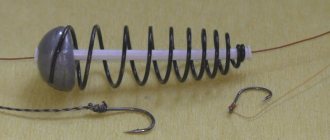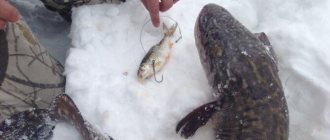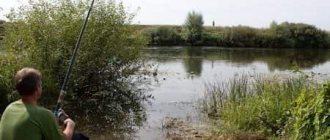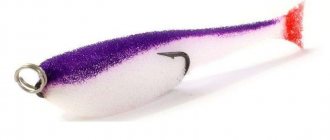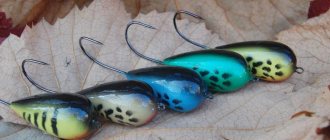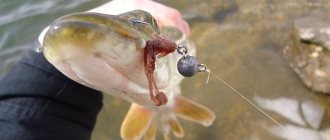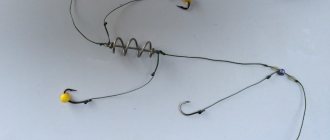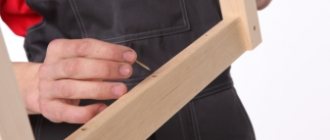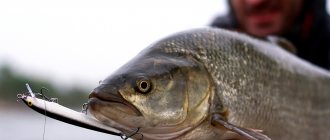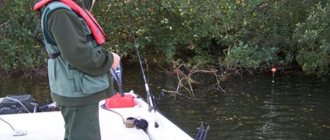Catching pike perch even in the middle of winter is no less interesting and exciting than at other times of the year. Of particular interest in winter fishing is fishing for pike perch using girders, but not all fishermen can boast of successful experience in such fishing. In practice, catching this predator does not require any special skills. It is important to know the lifestyle of the toothy predator during this period and some of its habits. One of the basic criteria for the success of fishing for pike perch in winter is to choose the right place and guess the time of day.
Where to catch pike perch in winter using girders
In proven reservoirs, everything is much easier: you can immediately go to the fishing spot and start fishing. If you have to fish in a new place, then it’s worth remembering a few habits of pike perch in order to find fishing spots.
If you have previously managed to catch pike perch in a certain place, you can safely go there again. A good catch is guaranteed.
Several features of the pike perch lifestyle:
- Pike perch is a predatory sedentary fish. They live in one location for a long time, going out to hunt on the nearest edges.
- The predator is predominantly nocturnal, hunting in the late evening or at dawn. This time will be the best period for successful fishing.
- During the day it stays mainly in holes and other depressions.
- At the beginning of winter and early spring, this species is especially active in terms of hunting.
It is a great success to choose the right place to catch a toothy predator. Trying to catch pike perch in areas of the reservoir that are not typical for its habitat is useless. The maximum that can be caught is a few stray specimens. Pike perch lives in the same place for a long time; when hunting, as a rule, it follows the same route. So, if you find a place once, then be sure of a good bite in the same location next time.
Design and types of vents
Fishing for pike perch on zherlitsa will differ from similar fishing for pike or perch due to special requirements for the equipment. The design itself, like others, must have a device for storing fishing line and give a signal when biting. Conventionally, they are divided into two large categories: above-ice and under-ice.
In the design of an over-ice girder, the reel and line should be above the ice surface, which is especially convenient during active fishing. Installing an under-ice rig is convenient for fishing at night, so you can forget about the gear for a few hours. At the same time, it must have a sufficient supply of fishing line. This is necessary because of the behavior of pike perch: as a rule, it does not immediately swallow the bait, but clamps it in its mouth and swims away several meters. To prevent the pike perch from breaking loose at this moment, it is important to have at least 20 meters of fishing line.
There are no clear requirements for the design of the vent. The main thing is that it is convenient for the fisherman to use. You can buy a ready-made one in a store or make it yourself from scrap materials.
Several design options for vents:
- flags for pike perch with a reel and screen. The most common and also convenient option. You can do it yourself at home;
- horizontal. The crossbar to which the reel is attached;
- vertical. Placed in the snow. Inconvenient to use on bare ice;
- kolobashki. Installed overnight;
- tripods. Inconvenient when there is a lot of snow.
If it is not possible to purchase girders at a fishing store, then make them yourself at home. To do this, you will need a small piece of plywood, from which a circle with a slot for equipment is cut out. A reel and a flag are attached to this circle, which will be triggered when bitten.
Do-it-yourself summer girder
With the arrival of summer, most reservoirs begin to be overgrown with aquatic and coastal vegetation. In addition, there are other underwater surprises that limit the use of spinning rods. As a rule, pike are found in hard-to-reach places, so the problem can be solved with the help of a girder.
For those who regularly catch pike with girders in winter, it will not be difficult to convert winter gear to summer gear. Unfortunately, there are fishermen who do not have information regarding the construction of girders. Basically, the vent is made from simple and affordable materials, sometimes unsuitable for other purposes. If you have to fish on a river, then you need to think in advance about how the tackle will be attached.
Do-it-yourself summer bait for pike. What could be simpler?
Gear rig for pike perch
The equipment of a zherlitsa for pike perch in winter will differ from others, which is associated with the behavioral characteristics of this species.
fishing line
- line length. It should be sufficient: the more, the better - from 20 meters;
- The thickness of the fishing line should be from 0.3 to 0.5 mm. If you set the line thinner, there is a high probability that a predator will break the line.
Sinker
If fishing is planned in a place with a small current, then install a sliding sinker weighing 15–20 grams and a leash with a diameter of 0.3 mm and a length of 4 m. The equipment should be completely in the water, and the bait should be at a distance of 20 cm from the bottom.
When fishing in a place with a strong current, you should be careful. It is necessary to attach a weight to the fishing line, and the hook and bait itself are higher, so that the sinker falls to the bottom under its own weight, and the bait is supported by the current at a distance.
Leash
The length of the leash should be about 50 cm in calm water and up to 1 meter in fast currents. The leader is a monofilament line slightly thinner than the main line.
Do not use a metal leash, as it will dramatically reduce the number of bites. But, if pike are found in the place where pike perch is caught, then the use of a metal leash will be relevant, since the other pike will bite.
Hooks
To catch pike perch on girders in winter, classic single hooks are used. (No. 9.12 according to the Russian classification, 1 and 3 - according to the European one.) Doubles or trebles are useless, since the pike perch first unwinds the fishing line, and only then swallows the bait. A double or triple hook can prematurely scratch a predator, which will scare it away and the fish will escape. Fishing with a tee is allowed only in places where pike perch are moored in snags or holes, where unwinding of the fishing line is not required.
Features of the equipment of the girder for currents and standing reservoirs
Fishing in still water and in strong currents will differ, but not significantly. The rigging for pike perch in the current will be slightly different. For a fast flow, you just need to place a weight on the end of the fishing line, which sinks to the bottom. This is necessary to keep the bait at the optimal depth of 20 cm from the bottom.
Blitz tips
- On the first ice, it is very good to use perch as live bait , this is explained by the fact that this fish holds depth well and does not tend to rise to the surface of the reservoir. At this time, pike perch mainly lives in the lower layers of water and bites will thus occur much more often.
- In winter , a school of these fish often stands in snags in the reservoir, so if you find such a place, you should place the girders along the perimeter of this area. The length of the fishing line for fishing in such places should not exceed 10 meters, so that the pike perch cannot go into a cluttered area and catch the tackle on snags.
- Braided fishing line is not used for winter fishing , the cord becomes covered with an ice shell much faster, and such fishing line wears out on the sharp edges of ice much more intensely than monofilament.
- When purchasing a ready-made girder in a store , you should choose a model with an alarm that, when bitten, rises by at least 0.5 meters, and the flag itself should be red, which can be easily visible on a snow-covered pond.
- able to catch live bait for pike perch using girders in the reservoir in which fishing is planned, so you should take care of the bait in advance. Without any competition, verkhovka, which is distinguished by its high survivability, can be used as live bait at this time of year. For transportation to the fishing site, the fry is placed in a canal - a special device for transporting live bait.
- Under some weather conditions, the pike perch bite in winter may stop completely. If during winter fishing a strong north or northeast wind blows, then you can already reel in the girders and go home.
- Unlike pike fishing , metal leashes are not used when fishing for pike perch in winter. Zherlitsa equipped with a metal leash will scare away pike perch at this time of year.
- In order to prevent the pike perch from being alerted by the moving sinker after the bite , the weight should be used in the shape of an olive and must be mounted in a sliding manner.
- To catch this fish with very small fish, it is better to use double hooks. They scare away predators less and allow the fish to be reliably caught with a sharp sting.
- In lakes you can set up to 20 poles overnight, and check the gear the next morning. This method of fishing is not poaching, although it allows fish to be hooked without human intervention. When installing the gear in this way, it is imperative to cover the hole with some sheet material and sprinkle snow on top.
Choice of live bait
If you choose the right place for fishing, then a good catch of pike perch using live bait is guaranteed even in deep winter. At this time of year, the predator is especially active and cannot resist the fish. All you need is live bait, since pike perch often won’t go for artificial baits.
To select live bait, you need to know about the structure of pike perch. It has a narrow throat, so you should choose narrow-bodied live bait. Live bait purchased in a store often does not provide a bite, and finding another one in winter can be more difficult. It is for this reason that some anglers refuse to fish for pike perch.
Suitable baits include: bleak, sprat for pike perch, verkhovka, minnow, small roach, gudgeon. They can be caught with a fishing rod, not necessarily in the same body of water. You can buy live bait in a store, but you should carefully inspect it before purchasing.
In parallel with catching pike perch using girders, you can try catching small fish for live bait using a fishing rod. Since this species in most cases lives in places where small fish accumulate, live bait is caught right on the spot.
To catch pike perch on girders in winter, it is important to acquire bait in advance. The fish must be alive, since the predator may not react to another one. You can try to catch dead bait in places with strong currents, where the movements of the fish will help simulate water flows.
Time and place
Fishing for pike perch using girders is especially popular in winter. This fish in the middle of winter or at the first freeze-up can be so hungry that such gear as a girder may seem like a poacher to the fisherman, the catches are so great, and the size of the fish differs greatly from catching pike perch in the daytime in the summer.
But, of course, not everything is so simple in this type of fishing. For successful fishing, you should choose the right place for fishing pike perch on the girders.
During the formation of the first ice, this predator begins to eat. You can catch this fish almost anywhere in the reservoir, because pike perch actively moves around the reservoir and when it encounters live bait, which appetizingly spins on a long fishing line, it attacks its prey and swallows it whole.
Going out on the ice at this time can be extremely dangerous and before you start fishing, you should make sure that the ice thickness is at least 10 cm.
Ice may not be strong enough at river mouths, as well as near aquatic plants. It is prohibited to be on the ice at night, or in conditions of poor visibility.
If the thickness of the ice cover is sufficient for safe fishing, then you can start fishing by making several holes at a considerable distance from each other.
If you install several girders with this arrangement, then after a while it will be possible to determine the most catchy place and make a few additional holes near the girder that is “very popular” with pike perch.
How to catch pike perch in winter using girders
For successful winter fishing for pike perch, girders should be installed in certain places in the reservoir, for example, near fallen trees, snags, edges, holes, and so on. It is better to mark the places in advance, and use an echo sounder or depth gauge to study the bottom.
A good way to place the vents is a curved line. With this arrangement, each subsequent vent is placed in a deeper place, which will allow you to take control of the entire slope. Also place the tackle in a checkerboard pattern, or, for example, around a hole or snag.
In order to have time to monitor all the fishing rods without getting tired or missing the fish, it is recommended to install no more than 7-10 gear at a distance of 20-25 cm from each other. It will be inconvenient to keep track of a large number of gear, and problems with supervisory authorities may also arise.
This predator lives in the same place for a long time, and the hunting route, as a rule, is the same. The most likely places for a predator to bite are holes, edges, snags, places near supports of bridges and other structures.
How to catch pike perch:
- A hole is made, the equipment is lowered to the bottom.
- Then 20–30 cm of fishing line is reeled in, and the length of the leash is set so that the bait is at a distance of 10–15 cm from the bottom.
- Then you need to take out the hook and attach it to the live bait on the girder and lower the rig again.
- If fishing is carried out in a strong current, then you can attach the bait immediately.
- As soon as the flag is straightened, you should not immediately hook the fish, since pike perch always behaves carefully and does not swallow the bait right away.
- You should also approach the gear with caution, as excess noise frightens the predator.
- When fishing for fish, you should not make sudden movements so as not to miss the fish.
Fishing technique
Now we’ll talk about the correct installation of the vent and the steps to take it off. The procedure for installing live bait for catching pike perch in winter on the current is as follows:
- We immediately equip the tackle with live bait.
- Let go of the reel and let the weight touch the bottom and tighten the line.
- We release a little fishing line to free the live bait.
- We fix the coil with a flag.
If you come fishing on a still body of water, the installation procedure will be slightly different:
- We move the load with the stopper to the hook.
- We lower the tackle to the bottom.
- We reel in 20-30 centimeters of fishing line.
- We fix the coil.
- We pull the equipment out of the water.
- We bait the fry.
- We put it in the water.
When biting, there is no need to rush; the right thing to do is to let the pike perch swallow the bait, this will take from 30 seconds to a minute, and only then hook it.
After fishing, you need to quickly reload the bait and lower the tackle into the water before the flock of predators moves away from the place. You can pull out 2-3 fish in a row from one hole.
How to make a winter bait for pike perch
The design of a pike perch for winter fishing will require the following elements:
- pipe with a diameter of 1.6 cm;
- a piece of plastic measuring 30x30 cm;
- coil;
- glue;
- spring;
- hacksaw for metal;
- ½ inch drill;
- drill;
- self-tapping screws with a length of 70 mm;
- clamp;
- 16 mm fitting for metal-plastic pipes with transition to external thread, 1/2 lock nut with washer for fitting.
Installation of a winter girder for pike perch is carried out as follows:
- As a base, take a piece of plastic of sufficient size, from which a circle or square with equal sides is cut out.
- A 0.5 cm wide cut is made from the outer edge to the center.
- It is necessary to retreat 7 cm from the center, where a hole is made with a prepared drill.
- A fitting is installed in the hole and secured to the base with a nut.
- Then a piece of metal-plastic pipe 30 cm long is taken, installed on the fitting and secured with a thread.
- At a distance of 20 cm from the base, the coil is attached using self-tapping screws so that the plane of the coil and the cut made in the base are parallel.
- A magnet is attached to the outer diameter of the coil.
- At the end, a spring 30 cm long is taken. It must be completely straightened. One end is secured to the plastic pipe with a clamp, and a small piece of fabric is glued to the other end with glue.
The alarm will work as follows: after casting the tackle, the spring will bend towards the reel and lock with a magnet. When bitten, the reel will begin to rotate, which will cause the spring to break away from the magnet, causing it to rise up along with the fabric.
